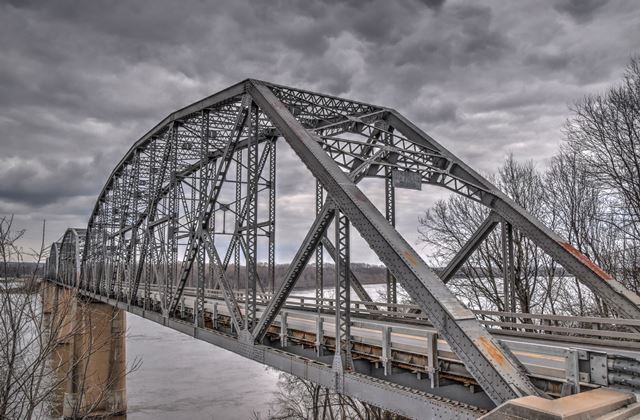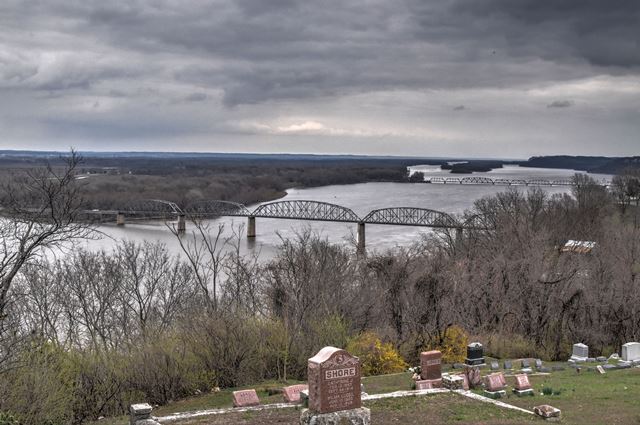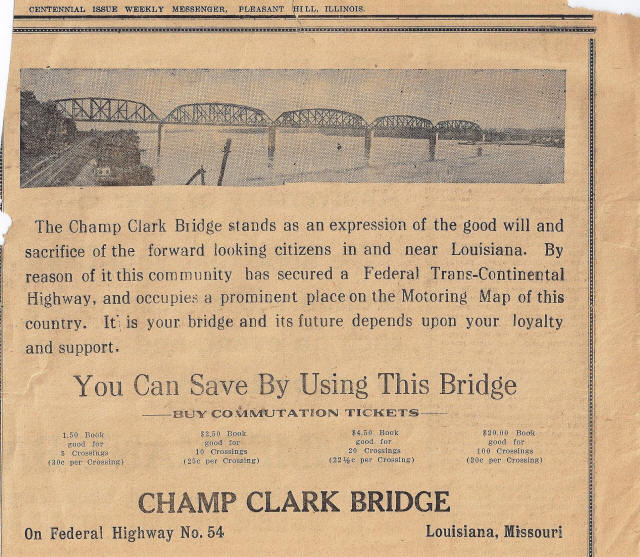We Recommend:
Bach Steel - Experts at historic truss bridge restoration.
BridgeHunter.com Phase 1 is released to the public! - Visit Now
Champ Clark Bridge

Primary Photographer(s): Nathan Holth
Bridge Documented: March 20, 2016
Louisiana: Pike County, Missouri and Pike County, Illinois: United States
Metal 18 Panel Rivet-Connected Pennsylvania Through Truss, Fixed and Approach Spans: Metal Deck Girder, Fixed
1928 By Builder/Contractor: Missouri Valley Bridge and Iron Company of Leavenworth, Kansas and Engineer/Design: Harrington, Howard, and Ash of Kansas City, Missouri
2005
418.7 Feet (127.6 Meters)
2,279.0 Feet (694.6 Meters)
20 Feet (6.1 Meters)
5 Main Span(s) and 7 Approach Span(s)
5996

View Information About HSR Ratings
Bridge Documentation
This bridge no longer exists!
Bridge Status: Demolished and replaced by MoDOT October 18, 2019.View Archived National Bridge Inventory Report - Has Additional Details and Evaluation
View Original Plans For This Bridge
View Missouri Historic Bridge Inventory Sheet For This Historic Bridge
View Historical Articles About This Bridge
This bridge is noted among large river bridges for its long-span simple truss spans, with no continuous or cantilever design. Its riveted Pennsylvania truss configuration is also uncommon. The bridge was designed by noted firm Harrington, Howard and Ash. One of the spans collapsed during construction and had to be rebuilt. See photo below.
This is a beautiful, historic, large river bridge. The lead agency in charge of the bridge is Missouri Department of Transportation. That means the bridge didn't stand a glimmer of a chance to be preserved. This bridge has been sentenced to the scrapyard, to be replaced by a ugly modern bridge with no beauty, character, or heritage. Sadly, there isn't much more to say than this, after over 10 years of watching MoDOT decimate what was once the largest collection in the country of large river truss bridges (Missouri River and Mississippi River Bridges) down to a sliver of what it once was, it is clear that even the few historic truss bridges which remain will not receive any more consideration for preservation despite their increased rarity due to past demolitions. Some other states with poor preservation track records, such as Pennsylvania, have slowly improved their efforts to preserve bridges after years of efforts on the part of preservationists to effect change. However, in Missouri these efforts have been completely fruitless. While both Pennsylvania and Missouri are guilty of demolishing some of the finest historic bridges in the country, Missouri stands out as the greater disappointment because even now at the final opportunities to save the last few bridges remaining, there is absolutely no interest whatsoever to save even a sliver of these historic bridges. Just a never ending complaints about the narrow width of these bridges, and the cost of maintenance. These complaints make no sense. A one-way couplet of bridges could provide two wide lanes of traffic and redundancy in case one bridge needs to be closed for repairs. As for cost of maintenance this also makes no sense, since other states and countries in this world maintain truss bridges without all the complaining about cost. If the bridge costs too much to maintain, its probably because it wasn't being maintained as well as it should have been. Deferring needed repairs increases overall cost. Repairs should be made as soon as deterioration is detected. Missouri would do well to look at how the state of Michigan maintains bridges like the Mackinac Bridge, Blue Water Bridge, etc. This level of maintenance represents the best use of taxpayer dollars in the long run. Soon it won't matter however, soon all of these bridges will be gone forever. And then the public will get to see how long these so-called wonderful modern bridges REALLY last. Future generations could face enormous costs if MoDOT's precious modern pre-stressed concrete bridges prove to be less long-lasting than they are advertised to last by the well-paid engineers who sell them to the public.
It is perhaps fitting that the photo-documentation took place under very gloomy skies that cast a depressing grey over everything the camera lens was aimed at. Even more fitting, some of the best photos and views of this bridge were had from a cemetery.

Above: Historical advertisement for the bridge, provided by Brent Freesmeyer.
![]()
Photo Galleries and Videos: Champ Clark Bridge
Bridge Photo-Documentation
Original / Full Size PhotosA collection of overview and detail photos. This gallery offers photos in the highest available resolution and file size in a touch-friendly popup viewer.
Alternatively, Browse Without Using Viewer
![]()
Bridge Photo-Documentation
Mobile Optimized PhotosA collection of overview and detail photos. This gallery features data-friendly, fast-loading photos in a touch-friendly popup viewer.
Alternatively, Browse Without Using Viewer
![]()
Maps and Links: Champ Clark Bridge
This historic bridge has been demolished. This map is shown for reference purposes only.
Coordinates (Latitude, Longitude):
Search For Additional Bridge Listings:
Bridgehunter.com: View listed bridges within 0.5 miles (0.8 kilometers) of this bridge.
Bridgehunter.com: View listed bridges within 10 miles (16 kilometers) of this bridge.
Additional Maps:
Google Streetview (If Available)
GeoHack (Additional Links and Coordinates)
Apple Maps (Via DuckDuckGo Search)
Apple Maps (Apple devices only)
Android: Open Location In Your Map or GPS App
Flickr Gallery (Find Nearby Photos)
Wikimedia Commons (Find Nearby Photos)
Directions Via Sygic For Android
Directions Via Sygic For iOS and Android Dolphin Browser
USGS National Map (United States Only)
Historical USGS Topo Maps (United States Only)
Historic Aerials (United States Only)
CalTopo Maps (United States Only)



